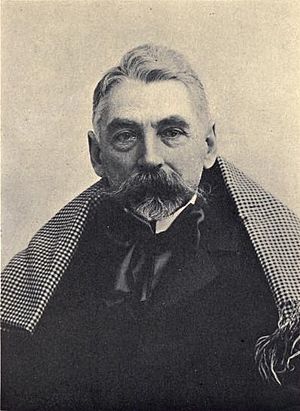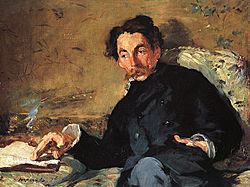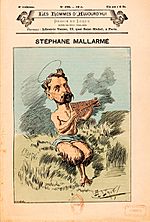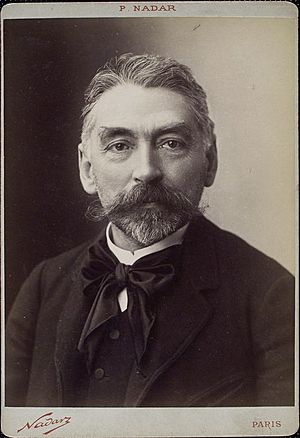Stéphane Mallarmé facts for kids
Quick facts for kids
Stéphane Mallarmé
|
|
|---|---|

Portrait of Mallarmé, by Nadar, 1896
|
|
| Born | Étienne Mallarmé 18 March 1842 Paris, France |
| Died | 9 September 1898 (aged 56) Vulaines-sur-Seine, France |
| Occupation | Poet |
| Nationality | French |
| Literary movement | Parnassianism Symbolism |
| Spouse |
Maria Christina Gerhard
(m. 1863) |
| Children | 2 |
Stéphane Mallarmé (pronounced MAL-ar-MAY; born March 18, 1842 – died September 9, 1898), whose real name was Étienne Mallarmé, was a famous French poet and critic. He was a very important Symbolist poet. His ideas and writings helped inspire many new art styles in the early 1900s, like Cubism, Futurism, Dadaism, and Surrealism.
Contents
About Stéphane Mallarmé
Stéphane Mallarmé was born in Paris, France. He went to a boarding school from 1852 to 1855. He worked as an English teacher for most of his life and didn't have much money.
However, he was well-known for his "salons." These were special meetings of smart people at his house in Paris. They would meet on Tuesdays (mardi in French) to talk about poetry, art, and ideas. Because of this, the group was called les Mardistes. Mallarmé had a big influence on many writers of his time through these meetings. For many years, these Tuesday sessions were a very important part of Paris's intellectual life. Famous visitors included W.B. Yeats, Rainer Maria Rilke, Paul Valéry, and Paul Verlaine.
Mallarmé also supported fairness during the Dreyfus Affair, a big political event in France.
On August 10, 1863, he married Maria Christina Gerhard. Their daughter, Geneviève, was born in 1864. Mallarmé passed away on September 9, 1898, in Valvins, which is now called Vulaines-sur-Seine.
Mallarmé's Unique Style

Mallarmé's early poems were a lot like the work of Charles Baudelaire, who was seen as a leader of Symbolism in literature.
Later in his career, Mallarmé developed a very unique style. He explored how the meaning of a poem connects with how the words are arranged on the page. This included using blank spaces and the look of the text. You can see this clearly in his last major poem, Un coup de dés jamais n'abolira le hasard (which means 'A roll of the dice will never abolish chance'), written in 1897.
Many people think Mallarmé's poems are very hard to translate into English. This is partly because his work often has many layers of meaning. Also, the sound of the words is very important in his poetry, not just their meaning. When his poems are read aloud in French, they can have different meanings that you might not notice just by reading them. For example, in one poem, the words ses purs ongles ('her pure nails') sound a lot like c'est pur son ('it's pure sound') when spoken. This idea of "pure sound" in his poetry has even inspired musical pieces. These sound tricks are very difficult to keep when translating his poems.
How Mallarmé Influenced Others
Influence on Music and Art
Mallarmé's poetry has inspired many musical works. For example, Claude Debussy's famous piece Prélude à l'après-midi d'un faune (1894) was inspired by Mallarmé's poem L'après-midi d'un faune (1876). Maurice Ravel also set some of Mallarmé's poems to music in Trois poèmes de Mallarmé (1913). Other composers like Darius Milhaud and Pierre Boulez also used his poetry in their songs.
The artist Man Ray's last film, Les Mystères du Château de Dé (The Mystery of the Chateau of Dice) (1929), was greatly influenced by Mallarmé's work. It even featured the line "A roll of the dice will never abolish chance."
Influence of Un Coup de Dés
Some people believe that Mallarmé's work, especially Un coup de dés, influenced the idea of hypertext. This is because he carefully used blank spaces and placed words on the page in a way that allowed readers to explore the text in different, non-linear ways.
For a long time, Un Coup de Dés was not published exactly how Mallarmé wanted it to look. In 2004, a new edition was finally printed that tried to match the special typography and layout Mallarmé had planned in 1897. This new edition was made using his original proofs and notes.
The poet and visual artist Marcel Broodthaers even created a version of Un coup de Dés where he replaced all the words with black bars, keeping only Mallarmé's unique layout.
Works
- In 1875, he translated Edgar Allan Poe's famous poem The Raven into French. The artist Édouard Manet created illustrations for it.
- L'après-midi d'un faune, 1876
- Les Mots anglais (English Words), 1878
- Les Dieux antiques (Ancient Gods), 1879
- Poésies (Poems), 1887
- Divagations (Wanderings), 1897
- Un coup de dés jamais n'abolira le hasard (A Roll of the Dice Will Never Abolish Chance), 1897
- For Anatole's Tomb (Pour un tombeau d'Anatole), 1961 (this was an unfinished work published after his death)
See also
 In Spanish: Stéphane Mallarmé para niños
In Spanish: Stéphane Mallarmé para niños



